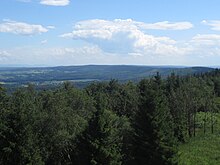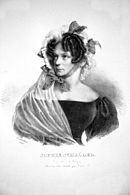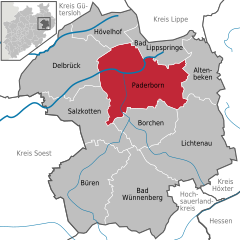Paderborn
This article needs additional citations for verification. (June 2015) |
Paderborn | |
|---|---|
 | |
 Flag  Coat of arms | |
show Location of the city of Paderborn within the district | |
 Paderborn | |
| Coordinates: 51°43′05″N 8°45′15″E / 51.71806°N 8.75417°ECoordinates: 51°43′05″N 8°45′15″E / 51.71806°N 8.75417°E | |
| Country | Germany |
| State | North Rhine-Westphalia |
| Admin. region | Detmold |
| District | Paderborn |
| Subdivisions | 8 |
| Government | |
| • Mayor (2020–25) | Michael Dreier[1] (CDU) |
| Area | |
| • Total | 179.38 km2 (69.26 sq mi) |
| Highest elevation | 347 m (1,138 ft) |
| Lowest elevation | 94 m (308 ft) |
| Population (2020-12-31)[2] | |
| • Total | 151,864 |
| • Density | 850/km2 (2,200/sq mi) |
| Time zone | UTC+01:00 (CET) |
| • Summer (DST) | UTC+02:00 (CEST) |
| Postal codes | 33041-33106 |
| Dialling codes | 05251, 05252, 05254, 05293 |
| Vehicle registration | PB |
| Website | paderborn.de |
Paderborn (German pronunciation: [paːdɐˈbɔʁn] (![]() listen))[3] is a city in eastern North Rhine-Westphalia, Germany, capital of the Paderborn district. The name of the city derives from the river Pader and Born, an old German term for the source of a river. The river Pader originates in more than 200 springs near Paderborn Cathedral, where St. Liborius is buried.
listen))[3] is a city in eastern North Rhine-Westphalia, Germany, capital of the Paderborn district. The name of the city derives from the river Pader and Born, an old German term for the source of a river. The river Pader originates in more than 200 springs near Paderborn Cathedral, where St. Liborius is buried.
History[]
Paderborn was founded as a bishopric by Charlemagne in 795, although its official history began in 777 when Charlemagne built a castle near the Pader springs.[4] In 799 Pope Leo III fled his enemies in Rome and reached Paderborn, where he met Charlemagne, and stayed there for three months. It was during this time that it was decided that Charlemagne would be crowned emperor. Charlemagne reinstated Leo in Rome in 800 and was crowned as Holy Roman Emperor by Leo in return. In 836, St. Liborius became the patron saint of Paderborn after his bones were moved there from Le Mans by Bishop Badurad.[5] St. Liborius is commemorated in Paderborn every year in July with the Liborifest.
The bishop of Paderborn, Meinwerk, became a Prince of the Empire in 1100. The bishop had several large buildings built, and the area became a place for the emperors to stay.[4]

The city was taken by Prussia in 1802, then by the French vassal state Kingdom of Westphalia from 1807 to 1813 and then returned to Prussia.
Native Friedrich Sertürner, a pharmacist's apprentice in Paderborn, was the first to isolate morphine from opium in 1804.
In 1914 the Paderborn military camp was turned into a prisoner of war camp named Sennelager.
In 1930, the See of Paderborn was promoted to archdiocese.
During World War II, Paderborn was bombed by Allied aircraft in 1944 and 1945, resulting in 85% destruction, including many of the historic buildings. It was seized by the US 3rd Armored Division after a pitched battle 31 March - 1 April 1945, in which tanks and flamethrowers were used during combined mechanized-infantry assaults against the city's southwestern, southern and southeastern approaches.[6]
After the city was reconstructed in the 1940s and 1950s, Paderborn became a major industrial seat in Westphalia.[5] The British Army retained a significant presence in the area until 2020, when British units were relocated back to the United Kingdom. Only a small training and enabling staff remain at Paderborn to facilitate temporary deployments to use the Sennelager Training Area.[7]
Geography[]


Paderborn is situated at the source of the river Pader, approximately 30 kilometres (19 mi) east of Lippstadt and approximately 50 kilometres (31 mi) south of Bielefeld on the Pader. The hills of the Eggegebirge are located east of the city.
Neighbouring municipalities[]
Subdivisions[]
The city of Paderborn consists of the following Stadtteile (city sections):
- Paderborn (city center)
- Benhausen
- Dahl
- Elsen
- Marienloh
- Neuenbeken
- Sande
- Sennelager
- Schloß Neuhaus
- Wewer
Demographics[]
Paderborn has a population of over 144,000, of which approximately 10% are students at the local university. Additionally, about 10,000 members or relatives of members of the British armed forces live within Westfalen Garrison, but are not included in the nominal population size.
| Largest groups of foreign residents | |
| Nationality | Population (2011) |
|---|---|
| 2,210 | |
| 1,212 | |
| 1,206 | |
| 903 | |
| 627 | |
| 578 | |
| 573 | |
| 326 | |
60% of the population are Catholics, 20% Lutherans and 20% members of other faiths or not religious.
Economy[]
Paderborn is the headquarters of the former Nixdorf Computer AG, which was acquired by Siemens in the early 1990s and known as Siemens-Nixdorf for about ten years. The company is now known as Diebold Nixdorf, which is still located in Paderborn, but Siemens retains a considerable presence in the city.
Many other information technology companies as well as industrial enterprises are located in Paderborn, too:
- Benteler AG (steel/tube, automotive, trade)
- Claas (farm machines)
- Deutsche Bahn AG (vehicle maintenance)
- dSPACE GmbH (engineering tools)
- Flextronics
- Fujitsu Technology Solutions
- Orga Systems GmbH
- Secure Computing Corporation
- Siemens AG (Siemens IT Solutions and Services)
- Zuken (PCB EMC Analysis and Design Software)
Paderborn is also home of the "Paderborner" brewery, which has belonged to the Warsteiner group since 1990.
Arts and culture[]
Paderborn has the largest computer museum in the world, the Heinz Nixdorf MuseumsForum, opened in 1996. From 2001 to 2005, it hosted the .
The town supports the Nordwestdeutsche Philharmonie for regular symphony concerts in the Paderhalle.
The city is known today for its exhibitions in three museums: the Kaiserpfalz, The Diocesan Museum and the Art Museum - Städtische Galerie.[8]
Image gallery[]

Central Paderborn and Cathedral

Saint George's church, Paderborn

Town hall Paderborn (Rathaus)

Inside the Bartholomäuskapelle

Photo of Paderborn city center
Twin towns – sister cities[]
Paderborn is twinned with:[9]
 Le Mans, France (officially since 1967, traditionally since 836, the oldest partnership of its kind)[10]
Le Mans, France (officially since 1967, traditionally since 836, the oldest partnership of its kind)[10] Bolton, England, United Kingdom (1975)
Bolton, England, United Kingdom (1975) Belleville, United States (1990)
Belleville, United States (1990) Pamplona, Spain (1992)
Pamplona, Spain (1992) Przemyśl, Poland (1993)
Przemyśl, Poland (1993) Debrecen, Hungary (1994)
Debrecen, Hungary (1994) Qingdao, China (2003)
Qingdao, China (2003)
Sports[]
Paderborn is nationally known as a center for American Sports. The local baseball team, the Paderborn Untouchables, has won many German championships. The local American Football team, the Paderborn Dolphins, has also enjoyed considerable success. In 2006 the Paderborn Baskets, the home basketball team of the city was promoted to the Bundesliga.
Paderborn Baskets (basketball)[]
In the past, the Paderborn Baskets played multiple seasons in the Basketball Bundesliga. They reached the playoffs in the 2008–09 season.
SC Paderborn 07 (football)[]
SC Paderborn 07 is the most successful football club in Paderborn. They were promoted to the Bundesliga, Germany's top flight, in 2019 but relegated back to 2. Bundesliga at the end of the same season.
The club was formed out of the 1985 merger of FC Paderborn and TuS Schloß Neuhaus as TuS Paderborn-Neuhaus and took on its current, shorter name in 1997. The Neuhaus club was founded in 1907 as SV 07 Neuhaus which was joined by the local side TuS 1910 Sennelager to become TuS Schloss Neuhaus in 1970. The Neuhaus and Paderborn teams played as tier III sides for most of their histories, as has the unified club. Today Paderborn plays its home matches at the Benteler Arena. In 2014, SC Paderborn was promoted to the Bundesliga for the first time. They are now in the top flight again after a thrilling promotion campaign.
Infrastructure[]
Transport[]

Paderborn is located at the Autobahn A 33, which connects Paderborn to the Autobahn A 2 in the north and the Autobahn A 44 in the south.
The main station is a regular stop for the InterCity on the Hamm–Warburg line and several local trains.
The Paderborn Lippstadt Airport connects Paderborn to the bigger German airports and offers flights to many locations in Europe. There is a bus shuttle between the airport and the Paderborn main train station. General Aviation and gliders are based at Paderborn-Haxterberg (site of the world gliding championships in 1981).
In Paderborn there is a bus system served by the PaderSprinter for local buses and the Bahnbus Hochstift for regional buses.
Education[]

Paderborn was once the oldest academic site in Westphalia. In 1614, the University of Paderborn was founded by the Jesuits but was closed in 1819. It was re-founded in 1972 as Universität-Gesamthochschule and transformed into a university in its own right in 2002. Today, it is attended by about 20,000 students.
There also are several theological and private academic institutes in Paderborn.
There are a number of grammar schools in the city, the most prominent of which are the Theodorianum and St. Michael Gymnasium[citation needed] , along with others such as the Goerdeler-Gymnasium. There are also a few British primary schools such as John Buchan School, which was located in Sennelager and mainly educated children of British military personnel and the garrison's employees until its closure in 2019.
Notable people[]




- Heinrich Aldegrever (1502–1558?), painter and engraver
- Carl Ferdinand Fabritius (1637–1673), painter
- Franz Anton Cramer (1776–1829), apothecary, supported the discovery of morphine
- Sophie Schröder (1781–1868), singer and actress
- Friedrich Sertürner (1783–1841), pharmacist, first to isolate morphine from opium
- Joseph Hermann Schmidt (1804–1852), physician, director, Charité Birth Department, Berlin
- George Henry Backhaus (1811–1882), Catholic priest
- Franz von Löher (1818–1892), politician, jurist and historian
- Christoph Ernst Friedrich von Forcade de Biaix (1821–1891), owner of the estate, judge and member of the German Reichstag
- Julius von Ficker (1826–1902), German-Austrian historian
- Joseph F. Rigge (1842–1913), the first president of Marquette College (now Marquette University)
- Aloys Loeher (1850–1904), American sculptor, exhibited at the 1893 Columbian Exposition
- Karl von Plettenberg (1852–1938), Prussian officer and later General of Infantry during WW1
- Clemens Baeumker (1853–1924), Catholic philosopher and philosophy historian
- Augustus F. Fechteler (1857–1921), Rear Admiral of the United States Navy during World War I
- Ella Bergmann-Michel (1895–1971), painter, photographer and documentary filmmaker
- Gustav Simon (1900–1945), Nazi Gauleiter in the Moselland Gau from 1940 until 1944 and Chief of the Civil Administration in occupied Luxembourg, died here
- Josef Wirmer (1901–1944), jurist and resistance fighter against National Socialism
- Friedrich Wilhelm Christians (1922–2004), banker
- Heinz Nixdorf (1925–1986), computer pioneer, entrepreneur and founder of Nixdorf Computer AG
- Walter Salmen (1926–2013), musicologist
- Werner Franke (born 1940), professor of cell and molecular biology
- Ulrich Vogt (born 1941), teacher and non-fiction author
- Mechtild Rothe (born 1947), politician (SPD) and member of the European Parliament
- Franz-Josef Bode (born 1951) bishop of the Roman Catholic Diocese of Osnabruck since 1995
- Andreas Fischer (born 1964), footballer
- Rüdiger Hoffmann (born 1964), cabaret artist and musician
- Bernd Hüttemann (born 1970), Vice President of the European Movement International and Secretary General of the European Movement Germany
- Stefan Gödde (born 1975), television presenter, radio presenter and reporter
- Judith Rakers (born 1976), journalist and television supporter (ARD)
- Carsten Linnemann (born 1977), economist and politician (CDU), member of the German Bundestag
Sport[]
- Klaus Ehl (born 1949), athlete (sprinter)
- Hans-Günther Vosseler (born 1949), swimmer
- Günter Kutowski (born 1965), footballer
- Martin Driller (born 1970), footballer
- Reiner Plaßhenrich (born 1976), football player and coach
- Jasmin Duehring (born 1992), Canadian cyclist
- Alexander Nübel (born 1996), footballer
- Tolgay Ali Arslan (born 1990), footballer
See also[]
- Paderborn method for teaching languages
- Disappearance of Katrice Lee
References[]
- ^ Wahlergebnisse in NRW Kommunalwahlen 2020, Land Nordrhein-Westfalen, accessed 29 June 2021.
- ^ "Bevölkerung der Gemeinden Nordrhein-Westfalens am 31. Dezember 2020" (in German). Landesbetrieb Information und Technik NRW. Retrieved 21 June 2021.
- ^ "Duden dictionary". Retrieved 7 December 2013.
- ^ Jump up to: a b Ed. Heribert Zelder, Tourist Information Services, Welcome to Paderborn, Stadt Paderborn: Paderborn, Germany, 2009.
- ^ Jump up to: a b Ed. Heribert Zelder, Tourist Information Services, Welcome to Paderborn, Stadt Paderborn: Paderborn, Germany, 2009.
- ^ Stanton, Shelby, World War II Order of Battle: An Encyclopedic Reference to U.S. Army Ground Forces from Battalion through Division, 1939-1946 (Revised Edition, 2006), p. 52
- ^ "The British Army in Germany". British Army. Retrieved 26 June 2021.
- ^ CREDO in Paderborn - Medieval Histories 2013: 9 ISBN 978-87-92858-11-5
- ^ "Paderborn und seine internationalen Partnerstädte". paderborn.de (in German). Paderborn. Retrieved 2021-03-07.
- ^ "Le Mans (Frankreich)". paderborn.de (in German). Paderborn. Retrieved 2021-03-07.
Further reading[]
- John M. Jeep, ed. (2001). "Paderborn". Medieval Germany: an Encyclopedia. Garland Publishing. ISBN 0-8240-7644-3.
- Makos, Adam (2019). (1st ed.). New York: Ballantine Books. pp. 245, 255, 268. ISBN 9780804176729. LCCN 2018039460. OL 27342118M.
External links[]
 Media related to Paderborn at Wikimedia Commons
Media related to Paderborn at Wikimedia Commons
| Wikivoyage has a travel guide for Paderborn. |
- Official website
 (in German)
(in German) - Paderborn region website —(in German)
- Ordinances of the "Fürstbistum Paderborn" online—(in German)
- Homepage of the annual RoboCup competition—(in English)
- University of Paderborn—(in German)
- Basketball: Paderborn Baskets—(in German)
- Introduction to the History of Paderborn—(in English)
- . Encyclopædia Britannica. 20 (11th ed.). 1911.
- Towns in North Rhine-Westphalia
- Paderborn
- Paderborn (district)
- Members of the Hanseatic League
- Province of Westphalia








